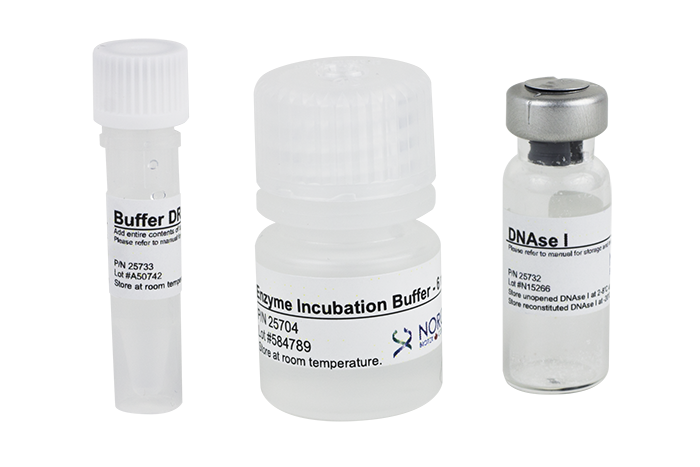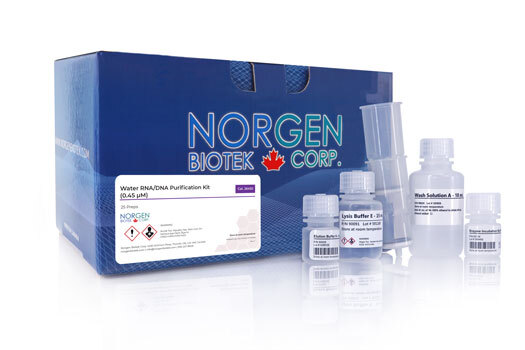Soil Total RNA Purification Kit
For the rapid preparation of inhibitor-free total RNA from soil

For research use only and NOT intended for in vitro diagnostics.
This kit has a supplementary protocol for the isolation of RNA from Waste Water. See the "Documentation" section for more information.
Soil Total RNA Purification Kit
For the rapid preparation of inhibitor-free total RNA from soil
Register today to receive an exclusive 15% off* on your first order.
Features and Benefits
- Isolate high quality total RNA from a variety of soil samples
- Process all types of soil, including common soil, compost and manure
- Remove all traces of humic acids and other inhibitors of PCR
- Isolates all sizes of RNA, including microRNA, without phenol
- Complete kit including bead tubes and humic acid removal columns (HAR)
- Purification is based on spin column chromatography that uses Norgen’s proprietary resin separation matrix
This kit provides a convenient and rapid spin column method to purify total RNA from small amounts of soil samples. All types of soil samples can be processed with this kit, including common soil samples and difficult soil samples with high humic acid content such as compost and manure. The kit removes all traces of humic acids and other inhibitors of PCR using humic acid removal (HAR) columns.
Norgen’s Soil Total RNA Purification Kit purifies all sizes of RNA, from large mRNA and ribosomal RNA down to microRNA and small interfering RNA without the need for phenol. The purified RNA is of the highest integrity and is inhibitor-free for any downstream application including microbiome studies, real time PCR and reverse transcription PCR for gene expression analysis, Next Generation Sequencing and more.
Details
Supporting Data
Figure 1. Isolation of Total RNA from Bacteria in Soil. Pseudomonas fluorescens was spiked into 250 mg samples of autoclaved soil and total RNA was isolated using Norgen's Soil Total RNA Purification Kit. RNA was visualized by running 7.5 µL of each 75 µL elution on a 1.2% agarose-formaldehyde RNA gel. Total RNA (large and small) of Pseudomonas fluorescens was recovered from the autoclaved spiked soil without any significant degradation, indicating that high integrity RNA can be purified from the microorganisms in the soil. Lanes 1 and 2 contain total RNA from Pseudomonas fluorescens, Lanes 3 and 4 contain total RNA purified from the autoclaved soil spiked with Pseudomonas fluorescens, and Lanes 5 and 6 contain RNA purified from the autoclaved soil (no RNA was found).
Figure 2. High Quality RNA Free from PCR Inhibitors. Pseudomonas fluorescens was spiked into 250 mg samples of autoclaved soil and total RNA was isolated using Norgen's Soil Total RNA Purification Kit. One microliter of each elution was then used as the template in a 20 µL RT-PCR reaction to detect the 16s rRNA. Lane 1 contains the results when total RNA from Pseudomonas fluorescens was used as the input, Lane 2 is the results when total RNA isolated from the autoclaved soil spiked with Pseudomonas fluorescens was used as the input, Lane 3 is the results when RNA purified from non-spiked autoclaved soil was the input, Lane 4 is a positive control and Lane 5 is the Negative control. As it can be seen the RNA purified from soil using Norgen's kit was of a high quality and can be successfully used in sensitive downstream applications.
|
Kit Specifications
|
|
|
Suggested Soil Input
(Clay, loam, sand, feces, compost) |
500 mg |
| Type of Soil Processed | All types, including common soil, compost and manure |
| Maximum Column Binding Capacity | 50 μg |
| Maximum Column Loading Volume | 650 μL |
| Time to Complete Purifications | 30 minutes |
Storage Conditions and Product Stability
All solutions should be kept tightly sealed and stored at room temperature. This kit is stable for 1 year after the date of shipment.
| Component | Cat. 27750 (50 preps) |
|---|---|
| Lysis Buffer I | 2 x 20 mL |
| Binding Buffer E | 6 mL |
| Solution BX | 9 mL |
| Lysis Buffer QP | 25 mL |
| Binding Buffer B | 30 mL |
| Wash Solution A | 18 mL |
| Elution Solution A | 6 mL |
| Bead Tubes | 50 |
| Spin Columns | 50 |
| Humic Acid Removal Columns | 50 |
| Collection Tubes | 100 |
| Elution Tubes (1.7 mL) | 50 |
| Product Insert | 1 |
Documentation
FAQs
Spin Column
Poor RNA recovery could be due to one or more of the following:
- Sample is not fresh.
It is critical to use a freshly collected soil sample. In the case of a frozen soil sample, slowly defrosting at 4°C is recommended to minimize the degradation of RNA.
- Homogenization was incomplete.
Depending on the type of soil, further vortexing with the flat bed vortex or bead beater equipment may be required. However, it is not recommended to increase the vortex time to longer than 10 minutes at maximum speed (flat-bed vortexer).
- Column has become clogged.
Do not exceed the recommended input amount of 500 mg soil. The amount of starting material may need to be decreased if the column shows clogging below the recommended levels. See also “Clogged Column”.
- Ethanol was not added to the lysate.
Ensure that the appropriate amount of ethanol is added to the lysate before binding to the column.
- Ethanol was not added to the Wash Solution A.
Ensure that 42 mL of 96-100% ethanol is added to the supplied Wash Solution A prior to use.
RNA can be degraded due to the following factors:
- RNase contamination.
RNases may be introduced during the use of the kit. Ensure proper procedures are followed when working with RNA. Please refer to “Working with RNA” at the beginning of this user guide.
- Improper storage of the purified RNA.
For short term storage, RNA samples may be stored at –20℃ for a few days. It is recommended that samples be stored at –70℃ for longer term storage.
- DNase used may not be RNase-free.
Ensure that the DNase being used for the optional On Column DNA Removal step is RNase-free, in order to prevent possible problems with RNA degradation.
If the RNA does not perform well in downstream applications, it may be due to one or more of the following:
- RNA was not washed with Binding Buffer B and Wash Solution A.
Traces of humic acids and salt from the binding step may remain in the sample if the column is not washed with Binding Buffer B and twice with Wash Solution A. Salt may interfere with downstream applications, and thus must be washed from the column.
- Ethanol carryover.
Ensure that the dry spin under the Column Wash procedure is performed in order to remove traces of ethanol prior to elution. Ethanol is known to interfere with many downstream applications.
Citations
| Title | Dependency of sanitation infrastructure on the discharge of faecal coliform and SARS-CoV-2 viral RNA in wastewater from COVID and non-COVID hospitals in Dhaka, Bangladesh |
| Citation | Science of The Total Environment 2023. |
| Authors | Nuhu Amin, Rehnuma Haque, Md. Ziaur Rahman, Mohammed Ziaur Rahman, Zahid Hayat Mahmud, Rezaul Hasan, Md. Tahmidul Islam, Protim Sarker, Supriya Sarker, Shaikh Daud Adnan, Nargis Akter, Dara Johnston, Mahbubur Rahman, Pengbo Liu, Yuke Wang, Tahmina Shirin, Mahbubur Rahman, Prosun Bhattacharya |
| Title | Monitoring SARS-CoV-2 variants in wastewater of Dhaka City, Bangladesh: approach to complement public health surveillance systems |
| Citation | Human Genomics 2023. |
| Authors | Rehnuma Haque, Mohammad Enayet Hossain, Mojnu Miah, Mahbubur Rahman, Nuhu Amin, Ziaur Rahman, Md. Shariful Islam & Mohammed Ziaur Rahman |


